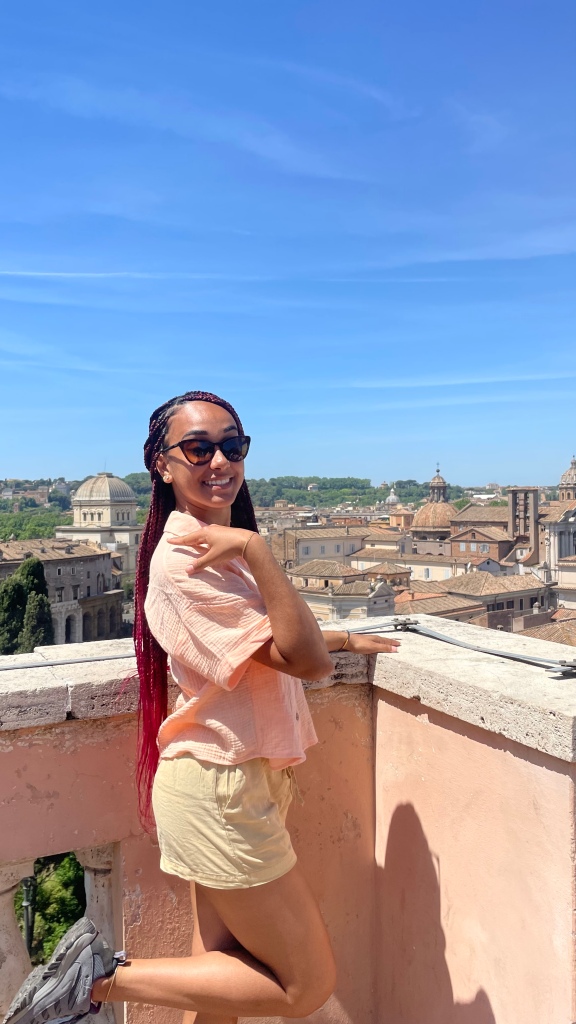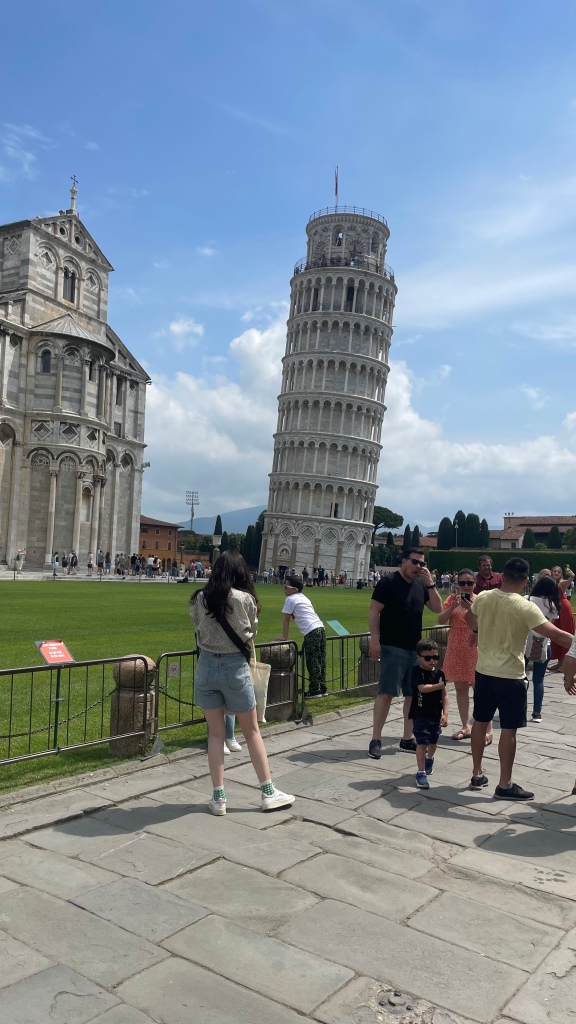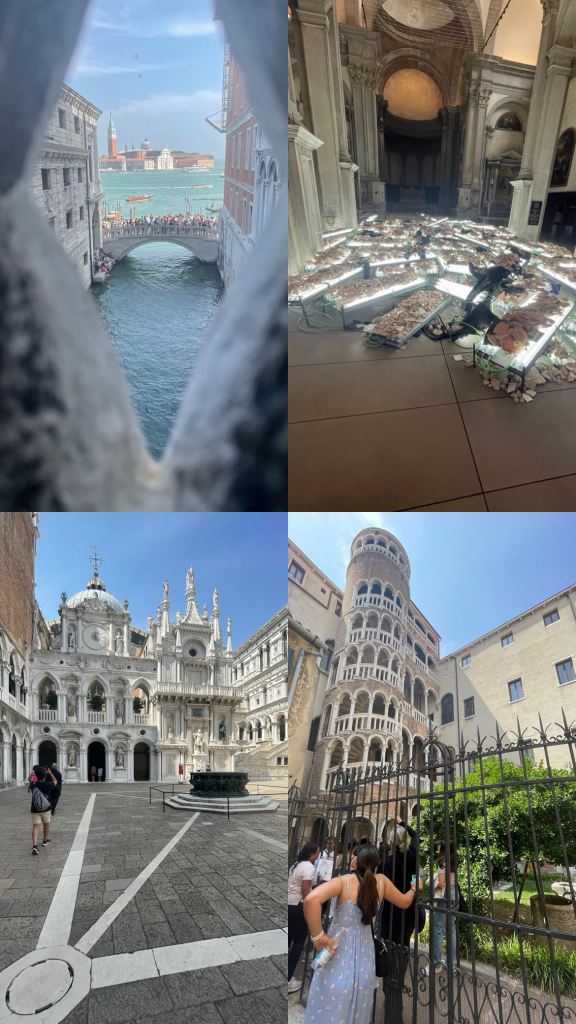
Janelle Ducheine (Juh-nel Du-shen) is a junior enrolled at Florida International University, majoring in Biological Sciences and Natural/Applied Sciences. From a young age she has always been passionate about helping others and have been apart of many projects and organizations to do so, ranging from tutoring elementary students to beach clean ups. However, she most enjoyed being apart of a clinical setting, believing that helping people from within will reflect on the surface, she decided on pursuing a career in Ophthalmology. On her free time, Ducheine enjoys exploring her hometown, Miami, with her friends, traveling to new locations, and exploring art museums.
Rome as Text
“Me and my woman-ly body” by Janelle Ducheine of FIU at The Capitoline Museum on May 12, 2022.

Being born and raised in Miami, I have never been scared to show parts of my skin. The suffocating temperatures year round wouldn’t allow me to be fully covered without nearly fainting. I grew up wearing mini shorts and crop tops, and never thought much of it, especially since my own mother and other female relatives encouraged it. The youth in my community also followed this trend, despite most of the US having unsolicited opinions about woman’s apparel. Of course, every now and then there would be the occasional intense stare of a perverted older man or the passive aggressive comment from a “prude” woman, but it wasn’t something I haven’t learned to overcome. Through this, I was able to become comfortable with my own body and accept it for it’s perks and flaws. So coming to Italy, it was only natural that my choice in clothing matched my habits.
Yet by the end of my first day there, I felt like I made the wrong choice.
I was greeted with similar temperatures and assumed the locals would have a similar ideology. But I was gravely mistaken. As we explored the various cities, it was evident that i was a foreigner.
Roman culture includes the acceptance, celebration, and normality of the female body. This was evident in many of the historic sites we visited. Like the room dedicated to Venus at the Capitoline Musuem. The placement in the center of the room and pose of the sculpture showcases her innocence and beauty in its purest form. Her stance slightly covered her intimate areas insinuating that she isn’t being excessively open, but comfortable in her image. I assumed, if the history of Rome is based on accepting and living in your body and sexuality, the people of Rome should be the same way right? Wrong.
I was instead welcomed by estranged and curious stares by adults and children alike. Women often seemed disgusted, men stoped and gawked in the middle of the streets, and children were confused. And all I wore out of the “norm” was a cropped shirt. Me peers and I were instantly uncomfortable, especially after the rate of being catcalled were dramatically increased.
The people of Rome in fact did not typically follow the pattern as their ancestors as I assumed. Despite the heat, they were mostly covered. I didn’t even see many natives wear regular shorts or tank tops. The most skin that would be shown would be when women wore dresses, the shortest being right above the knee.
Seems like the people of Miami take on more ancient Roman traits (in terms of their bodies) than many current Italians.
Pompeii as text
“Forgotten city” by Janelle Ducheine of FIU at Pompeii on May 16, 2022.

The eruption of mount Vesuvius is easily one of the most horrific tragedies in the history of Italy. At the time, Pompeii was one of the newer acquired territories of Rome, under its reign for less than 200 years. Although it was small, it was a prosperous city that was a hub for the production of fish sauce. Ironically, the city did not receive aid from the Roman government at the time of the explosion despite its economic success. From a political point of view, it makes sense to choose the more important subject at the time, which was the construction of the colosseum. But from a economic point of view , it does not coincide with their ideals they were trying to spread. The Roman Empire went through a phase of constant expansion, they conquered many countries all throughout Europe in search for financial advances. Pompeii, once conquered, was tending to this standard fluently. The complete disregard of the well-being of its people likely made a significant Impact on the economic well-being of the empire.
Before the fall of Pompeii, the city was well advanced in many fields making day to day activities simpler, many of which are still used today. The concessions stand where food was made and kept warm is a modern day stove. The reflective stones on the ground are now todays’ road lights. Many modern day individuals, especially Americans, would like to consider themselves the original creatives to their work when I’m reality it is the rework of something from the past.
Assisi as text
“Green Thumb” by Janelle Ducheine of FIU at Pompeii on May 23, 2022.

Home to a couple thousand people, Assisi is seemingly trapped in the medieval era. The compact stone homes reflect how locals were and currently still are living in close proximity with each other. Due to the size of the town, it does not dominate a specific industry and typically generates profit during tourist seasons. But even then, locals still have to be extremely self sustainable to be able to manage. The nature of this town has remained constant throughout the majority of its history, and because of this was able to foster one of the greatest revolutions to the Christian world.
St. Francis of Assisi was able to save the Catholic Church from its lineage of corruption, and spread the true word of Christ for all to hear in a welcoming manner.
One of his main teachings involved recognizing man as not the owners of the earth but rather the care takers of the land. He is most known for preaching to birds, since they too are also gods creatures, although his sermons were not limited to only birds but also fish and rabbits. This ideology is the stepping stone to modern ecological restoration and preservation. Countries worldwide have sites and national parks in efforts to maintain the natural setting of the earth. There are even big corporations and organizations such as PETA that fight for the well-being of animals. When referencing towards ending the cruelty of factory farming animals they explained it would result in “healthier living for you together with compassion for God creatures”. This is directly a result of St. Francis recognizing the equal importance of animals and land.
– “Animals Are Not Ours.” PETA, http://www.peta.org/media/psa/compassion-gods-creatures-030. Accessed 24 May 2022.
Pisa as text
“Wonders uncovered ” by Janelle Ducheine of FIU at Pisa on May 25, 2022.

Famously known for the leaning tower,
Granting mankind beauty, knowledge, and bower
The city however is richer in culture
Although taken advantage by the notorious kultur
Rich in maritime export,
But berated by socio/political sport
Tis the Birthplace of a rowdy kid, lacking attention in the church
Whom unlocked the basis of science through his research
defining and defying the laws of gravity to his students,
Assuring his discovery using his factual influence
The ease of Arabic numbers is a fact Fibonacci realized,
A universal rule on mathematics was idealized
Reoccurring patterns in nature he uncovered,
But was it created or discovered?
Holy baptistery filled with satisfying soulful sounds,
Sheltering believers within it’s bounds
A holy temple only small in size while large in pride,
Catching the attention of visitors world wide
The tower itself was a great mystery to all,
Wondering how is it that it did not fall
Its structure being altered as centuries fly past,
Is exactly how Pisa’s identity was amassed
Florence as text
“Unplanned parenthood” by Janelle Ducheine of FIU at Florence on May 29, 2022.

Often times, the things that interest me most or that I learn from the most are from situations that I least expect. Therefore, on one of my free days I spent it solo exploring the gorgeous Tuscan city of Florence. No set destination or time limit, I allowed myself to move to whatever space drew my attention. At one point I encounter a vast open plaza, at one end was a museum named “Museo degli Innocenti”. I curiously walked in and was surprised by murals of childlike drawings at the entrance. Turns out, it is a orphanage-turned-museum from the 15th century. At the time there were only 2 locations that took in children. Because of this scarcity, by the second year they already housed and cared for over 1000 children. They were nurtured and taught by wet nurses and nuns. During and after they took in children anonymously, they took extensive notes on the children, their health, and even whatever objects/notes/etc they came in with. Over the years they became avid in advocating for the rights and well-being of children, single mothers, and families in the region. Although not in business currently, their guidelines and standards of care was a direct reflection of the UNESCO rules, proving their genuine care for primarily abandoned youth.
Florence as text
“More than meets the eye” by Janelle Ducheine of FIU at Florence on June 2, 2022.

From at least a new travelers’ perspective, the lush environment of cinque terre is the sole attraction of the small towns. From the medieval style architecture, the infinite shades of green and blue, or the warm interactions between locals. Of course this location would be a hotspot for many tourists and considered a UNESCO world heritage sight. But to say that is the only reason would be an oblivious assumption.
The history behind these towns is rich and distinct, especially when compared to sister towns such as Levanto. It isn’t blatantly obvious for the world to see however, uncovering it’s roots requires hiking shoes, stamina, and ample amounts of water. Throughout each of the five towns (Monterosso, Vernazza, Corniglia, Manarola, and Riomaggiore) there are many religious spaces and temples that pilgrims would hike and pray at while on a religious journey. An important stop would be the Santuario de Savonarola, worshipping an important figure during the renaissance that unapologetically fought corruption in the church.
Many religious subgroups also settled into the land, one of the more commonly known being the capucin. These are a group of monks that dedicate their life and body to prepare their souls for the afterlife. Behind the chapel was a cemetery with dates as far back the mid 1800s. This is located at the very top of steep hill in Monterosso, overlooking the four other towns.
While not noticing the breathtaking views of nature in cinque terre, the chapels underneath reveal how the cities came to be.
Venice as Text
“More than meets the eye” by Janelle Ducheine of FIU at Venice on June 2, 2022.

A people infamous for their dominance at sea,
Gained their expertise because they had to flee
Land they cultivated and called their home,
Were where barbarians took advantaged and roamed
The Islands were built from crafty materials they find,
Turned out to be a huge economic gold mine.
To complete the city a religious centerpiece was sought,
From the muslims’ Saint Mark’s body was hidden and brought
For many years, the cluster of islands grew in clout,
Until a neighboring country found a new route.
To bypass the main intersection between cultures,
After the same riches they took like vultures.
Much like the rest of the peninsula believing in religion,
But not using the same rules creating great division.
The pope displeased and demanding obedience,
Locals ignoring and embracing their deviance
The lack of space making a lack of roads,
Leading to intricate waterways meeting at nodes
Skilled gondoliers understanding the emotions of waves,
Costly fares for rides they gave
The old city thought to be sinking,
Centuries worth of history, art, and pride is risking
Although prime of city is a piece of the past,
The influence of Venice can not be surpassed